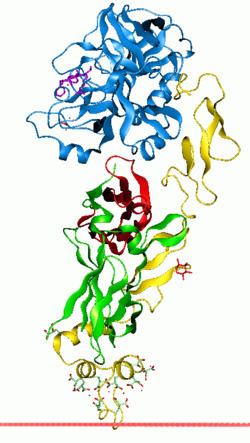Entrez 2155 | Ensembl ENSG00000057593 | |
 | ||
External IDs OMIM: 613878 MGI: 109325 HomoloGene: 7710 GeneCards: F7 | ||
Factor VII (EC 3.4.21.21, blood-coagulation factor VIIa, activated blood coagulation factor VII, formerly known as proconvertin) is one of the proteins that causes blood to clot in the coagulation cascade. It is an enzyme of the serine protease class. A recombinant form of human factor VIIa (eptacog alfa [activated], NovoSeven) has U.S. Food and Drug Administration approval for uncontrolled bleeding in hemophilia patients. It is sometimes used unlicensed in severe uncontrollable bleeding, although there have been safety concerns. A biosimilar form of recombinant activated factor VII (AryoSeven) is also available, but does not play any considerable role in the market.
Contents
- Insidermedicine in depth november 4 2010 recombinant activated factor vii
- Physiology
- Structure
- Genetics
- Role in disease
- Medical uses
- Interactions
- References
Insidermedicine in depth november 4 2010 recombinant activated factor vii
Physiology
The main role of factor VII (FVII) is to initiate the process of coagulation in conjunction with tissue factor (TF/factor III). Tissue factor is found on the outside of blood vessels - normally not exposed to the bloodstream. Upon vessel injury, tissue factor is exposed to the blood and circulating factor VII. Once bound to TF, FVII is activated to FVIIa by different proteases, among which are thrombin (factor IIa), factor Xa, IXa, XIIa, and the FVIIa-TF complex itself. The complex of factor VIIa with TF catalyzes the conversion of factor IX and factor X into the active proteases, factor IXa and factor Xa, respectively.
The action of the factor is impeded by tissue factor pathway inhibitor (TFPI), which is released almost immediately after initiation of coagulation. Factor VII is vitamin K dependent; it is produced in the liver. Use of warfarin or similar anticoagulants decreases hepatic synthesis of FVII.
Structure
Factor VII shares a common domain architecture with factors IX and X.
Genetics
The gene for factor VII is located on chromosome 13 (13q34).
Role in disease
Factor VII deficiency (congenital proconvertin deficiency) is rare and inherited recessively. It presents as a hemophilia-like bleeding disorder. It is treated with recombinant factor VIIa (NovoSeven or AryoSeven).
Medical uses
Recombinant factor VIIa, marketed under the trade names AryoSeven and NovoSeven, is used for people with hemophilia (with Factor VIII or IX deficiency) who have developed antibodies against replacement coagulation factor.
It has also been used in the setting of uncontrollable hemorrhage, but its role in this setting is controversial with insufficient evidence to support its use outside of clinical trials. The first report of its use in hemorrhage was in an Israeli soldier with uncontrollable bleeding in 1999. Risks of its use include an increase in arterial thrombosis.
Recombinant human factor VII while initially looking promising in intracerebral hemorrhage failed to show benefit following further study and this is no longer recommended.
Interactions
Factor VII has been shown to interact with tissue factor.Also reacts with protein kinase C.
